
Mastering Budgeting: Top Strategies for Small Business Success
- June 4, 2023
- By Aidan Dwyer
As any small business owner can tell you, budgeting is one of the most critical tasks for maintaining a healthy business. As important as it is, budgeting is a very tedious and confusing project, especially for anyone who is not great at accounting. Below, we have broken down the budgeting process into four easy steps to follow:
Look At Your Revenue
When it comes to smart budgeting for your small business, one of the fundamental steps is to carefully analyze your revenue. By thoroughly examining your income streams, you can gain a clear understanding of where your money is coming from and identify areas of potential growth or improvement. This analysis can help you make informed decisions about resource allocation, cost management, and investment opportunities. By regularly monitoring and assessing your revenue, you can adapt your budgeting strategies accordingly, ensuring that your business stays financially stable and profitable.
Subtract Your Costs
Now that you have seen how much money is coming in, it’s important to look at the money leaving your account. You can divide these into either fixed or variable costs. When budgeting a business, determining your fixed costs and mitigating your variable costs is crucial to success. Fixed costs are any costs that your business incurs during normal operation. Some examples of fixed costs might be payroll, rent, and utilities. Variable costs, as the name suggests, are costs that fluctuate depending on usage. When money gets tight, these are the first items that should get trimmed. But when money is good, you can use variable costs to expand budgets such as marketing and discretionary costs.
Contingency Funding
Once you have taken care of your fixed and variable costs, it is time to take money out of what is leftover. Your contingency fund is essentially a safety fund for anything that may come up, and something always comes up. These unexpected charges can be a huge blow to your business’s budget. Especially, if you did not prepare to handle them. If your budget does not look like it will have enough left over to cover a contingency fund for anything that comes up, you may consider taking out a Small Business Line Of Credit to have extra security.
Make a Bottom Line Profit and Loss Statement
A bottom-line profit and loss statement provides crucial insights into the financial performance of your small business. By regularly creating and reviewing this statement, you can identify trends, pinpoint areas for improvement, and make informed decisions to boost profitability. Also, this document defines profit loss for every certain period of time. If this final number is lower than where you want it to be, we recommend that you look into additional financing for your business. Looking for financing options? See which of our REIL Capital services are right for you!





